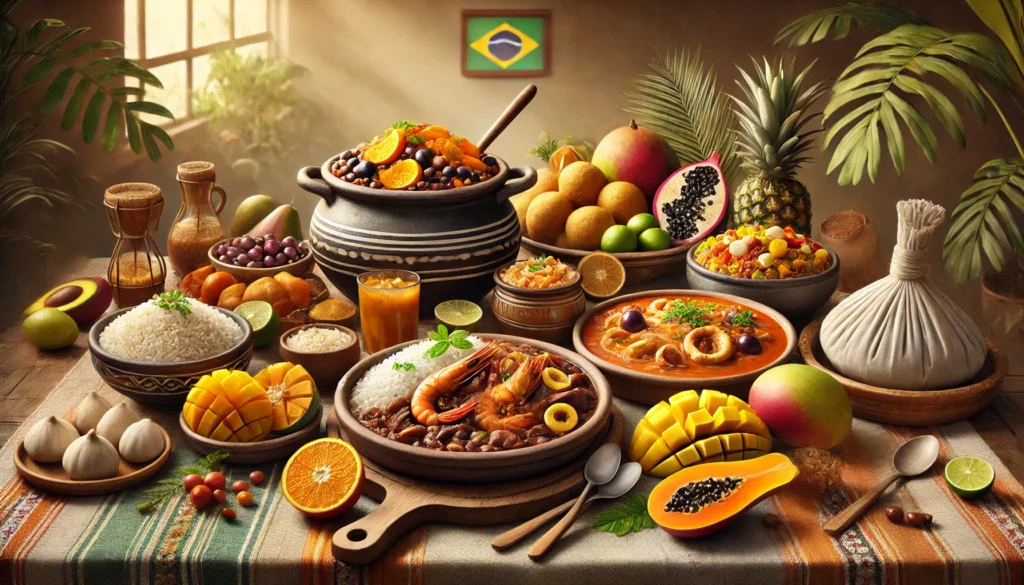Ads
When it comes to gastronomy, Brazil is a plateful – literally! From north to south, the diversity of flavors, spices, and traditions is breathtaking.
Each region of the country has its own gastronomic peculiarities, which delight both Brazilians and foreigners who visit the country.
Today, I'll guide you through this delicious journey, exploring Brazil's most iconic dishes and what makes them so special.
The richness of Brazilian cuisine: a meeting of cultures
Before we delve into the dishes, it is worth noting that Brazilian cuisine is the result of a historical encounter between indigenous, African, and European cultures.
This unique blend has resulted in recipes that are true masterpieces of flavor and creativity. Shall we discover some of these delicacies?
Ads
1. Feijoada: the classic that wins hearts
Feijoada is practically a national symbol. This dish, made with black beans and a variety of meats, is traditionally served with white rice, farofa, sauteed kale, and orange.
Legend has it that feijoada was born from the creativity of enslaved people, who took advantage of the less noble cuts of meat and combined them with beans, an abundant food in the country.
If you want to try an authentic feijoada, look for restaurants that serve it on Wednesdays and Saturdays, classic days to enjoy this dish.
2. Acarajé: the treasure of Bahia
In Bahia, acarajé is much more than a dish; it's a cultural experience. Made with cowpea dough and fried in palm oil, it's filled with vatapá, dried shrimp, and other delicacies.
Eating acarajé by the sea in Salvador is one of those experiences that stays etched in your memory.
3. Pato no tucupi: the taste of the north
In northern Brazil, pato no tucupi is a true institution.
This dish is prepared with tucupi, a broth extracted from bitter cassava, and jambu, an herb that causes a tingling sensation in the mouth.
The combination is unique and incredibly tasty.
4. Moqueca: the rivalry between Bahia and Espírito Santo
Moqueca is another dish that divides opinions. While the Bahian version uses coconut milk and dendê (palm oil), the Capixaba version is lighter, prepared with oil and annatto.
Regardless of the version, the result is a fish and seafood stew that pairs perfectly with rice and pirão.
5. Gaucho barbecue: the celebration of meat
In southern Brazil, churrasco is taken seriously. Made with high-quality cuts of meat, seasoned only with coarse salt and grilled over charcoal, it's served at parties, family gatherings, and, of course, in churrascarias (steakhouses).
If you haven't yet tried an authentic gaucho-style barbecue, you're missing out on one of the best gastronomic experiences in the country.
6. Brigadeiro: the sweet treat that sweetens any moment
No list would be complete without mentioning brigadeiro, Brazil's most beloved sweet.
Made with condensed milk, cocoa powder and butter, it is rolled in chocolate chips and is always present at parties and celebrations.
Is there anything more Brazilian than eating brigadeiro straight from the pot?

The importance of cuisine for Brazilian identity
The dishes we mentioned are just a sample of Brazil's rich gastronomy.
Each region has its own recipes, ingredients, and preparation methods that tell stories and reflect the local culture. What about you?
Do you have a favorite Brazilian dish or a special story related to its cuisine? Share it in the comments, and who knows, we might even include your suggestion in a future article!
Conclusion
Whether it's with a feijoada on Saturdays or a brigadeiro on an ordinary day, Brazilian cuisine is an invitation to celebrate life.
So, the next time you're in the kitchen or visiting a restaurant, give one of these dishes a try. You won't regret it!
And don't forget: share this article with your friends and family. After all, sharing the flavor is sharing happiness!
Frequently Asked Questions about the Best Dishes in Brazil
1. What makes Brazilian gastronomy unique?
Brazilian cuisine is the result of a blend of indigenous, African, and European influences. Each region of the country has unique ingredients and techniques that reflect its history and culture. This creates an impressive variety of dishes, ranging from traditional stews to irresistible desserts.
2. What is the most representative dish of Brazil?
Feijoada is considered one of the most emblematic dishes. It is a black bean stew with various meats, served with rice, farofa, kale, and orange. Its origin is linked to the history of enslaved people in the country.
3. Where can I try an authentic feijoada?
Feijoada is traditionally served on Wednesdays and Saturdays in Brazilian restaurants. If you visit Brazil, seek out local establishments specializing in it to experience it at its best.
4. What is the difference between Bahia moqueca and capixaba?
Bahian moqueca includes coconut milk and dendê oil, giving it a more intense, tropical flavor. Capixaba moqueca, on the other hand, uses oil and annatto, resulting in a lighter dish. Both versions are delicious and worth trying.
5. What makes acarajé special?
Acarajé is a traditional dish from Bahia, made with cowpeas and fried in palm oil. It is filled with vatapá (a type of stew) and dried shrimp. Besides its flavor, it represents a rich Afro-Brazilian cultural heritage.
6. Is brigadeiro only served at festivals?
Although brigadeiro is a classic party treat, it's also common to make it at home as a sweet for any occasion. It's easy to make and perfect for sharing.
7. What Brazilian dish would you recommend to a tourist?
It will depend on the region you visit, but trying the churrasco gaúcho in the south, the pato no tucupi in the north, or the moqueca on the coast is essential for an authentic gastronomic experience.